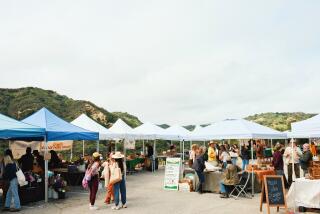Market Watch: Winter shopping strategies at farmers markets
Frequent heavy rains and holiday closures on weekends have made recent weeks challenging for farmers market growers and shoppers. California’s dominance in fruit and vegetable production stems largely from the rarity of rain during the peak summer season for many crops, allowing them to mature and be harvested with relatively few problems from spoilage. That advantage was turned on its head recently, as crops were damaged and farmers couldn’t harvest them or drive to market.
Many farmers are taking well-deserved breaks for the holidays, but for others, just showing up at a market can require heroic efforts. At Wednesday’s Santa Monica market, James Birch of Three Rivers told customers how he had spent much of the day before trying to extricate farm vehicles stuck in the mud. Leticia Garcia explained her absence the previous week by showing photos on her cellphone of the road from her family’s farm in De Luz, which had been washed out by a storm.
To make good choices, experienced customers recognize that some crops are more vulnerable than others to damage from rain. Satsuma mandarins, for example, have tender, relatively porous rinds that can become saturated with water, resulting in rot. That doesn’t necessarily mean one needs to stop buying satsumas, just choose them carefully and eat them soon. Clementines have relatively smoother, tighter rinds that repel water better, although their flavor, too, can be somewhat diluted after a storm.
Delicate greens like red leaf lettuce fare less well than tougher leaves like kale and parsley. Pelting rain beats up ripe or almost-ripe strawberries, so we won’t be seeing many of them for at least the next week or two. Not all the news is bad, however: Louis Mello of San Luis Obispo says the wet weather will result in a continuing bountiful harvest of California chanterelles and moderate prices.
Overall, savvy farmers market shoppers recognize the challenges farmers face and are more tolerant of dirt or cosmetic blemishes on their produce. They know that during rainy weather it’s especially important to get to markets early, because many items are in short supply. They search out the most knowledgeable vendors and ask more questions. And they realize that the shelf life of many items, even fairly hardy staples like broccoli, will be shorter when they’ve been wet for a while.
Winter apples
Apples, of course, have all been harvested by now and so are not really affected by the rain. With other fruits like pears, persimmons and pomegranates coming to the end of their seasons, apples are one of the few dependable fruits, other than citrus, available throughout the winter.
Supermarkets, of course, sell them all year. That’s because they import apples from the Southern Hemisphere during our off-season and because commercial storage techniques — such as controlled-atmosphere warehouses and the application of SmartFresh, a gas that blocks the ripening effect of ethylene — can maintain the fruit in good condition for months longer than the simple cold storage that most farmers market vendors use.
There’s a huge advantage to keeping apples crunchy longer by these methods. But they also reduce aroma and flavor, because the suppression of ethylene, a natural plant hormone that makes fruit ripen and eventually decay, also reduces synthesis of aromatic compounds. The truth is, the storage life of many apples considerably exceeds their optimal flavor life.
Conversely, apples bought at farmers markets have rarely been treated in these ways. Under ideal timing and circumstances, this gives them a flavor advantage. But the early varieties, such as Gala and Jonagold, go soft sooner. The best apples at farmers markets in winter and beyond are those that keep well naturally for long periods because of their slow ethylene response: standard varieties such as Fuji, Pink Lady and Granny Smith, as well as more esoteric ones like Sundowner, Lady Williams and Hauer Pippin.
Buying winter apples presents something of a conundrum for shoppers focused on fresh seasonal produce. Traditionally, stored apples were a mainstay of winter fruit consumption in temperate regions; in fact, fruit professionals recognized that many long-storing varieties did not even reach their peaks until several months after harvest. (Part of that may have been that in northern districts with shorter growing seasons, apples often are not harvested as mature and sweet on the tree as in California, and so are quite sharp at first and require some time for mellowing.) So eating apples in winter, even though they’ve been off the tree for a few months, is well in keeping with traditional, thoughtful foodways.
In Southern California we do have more choices in winter for freshly harvested local fruit, like citrus, cherimoyas, sapotes and (when they recover from recent deluges) strawberries. With the current mixture of varieties and storage techniques, apples do in time lose not only some of their crunch, but the acidity and aroma that make them pleasurable. The upshot is, even well-chosen local apples are not as exciting now as they were during California’s prime harvest season from late summer through autumn, with its abundance of varieties and flavors. But they’re still a healthy, juicy snack, and a worthy component of the farmers market shopping basket for the next several months.
More to Read
Eat your way across L.A.
Get our weekly Tasting Notes newsletter for reviews, news and more.
You may occasionally receive promotional content from the Los Angeles Times.










